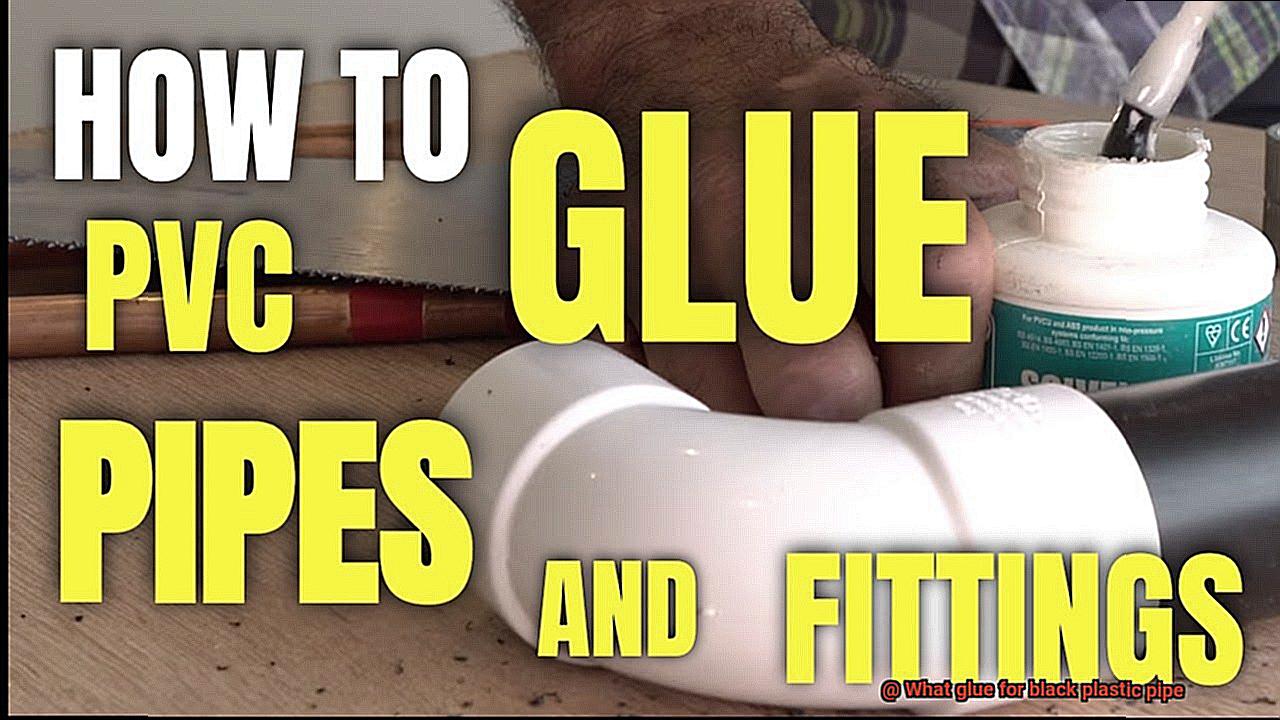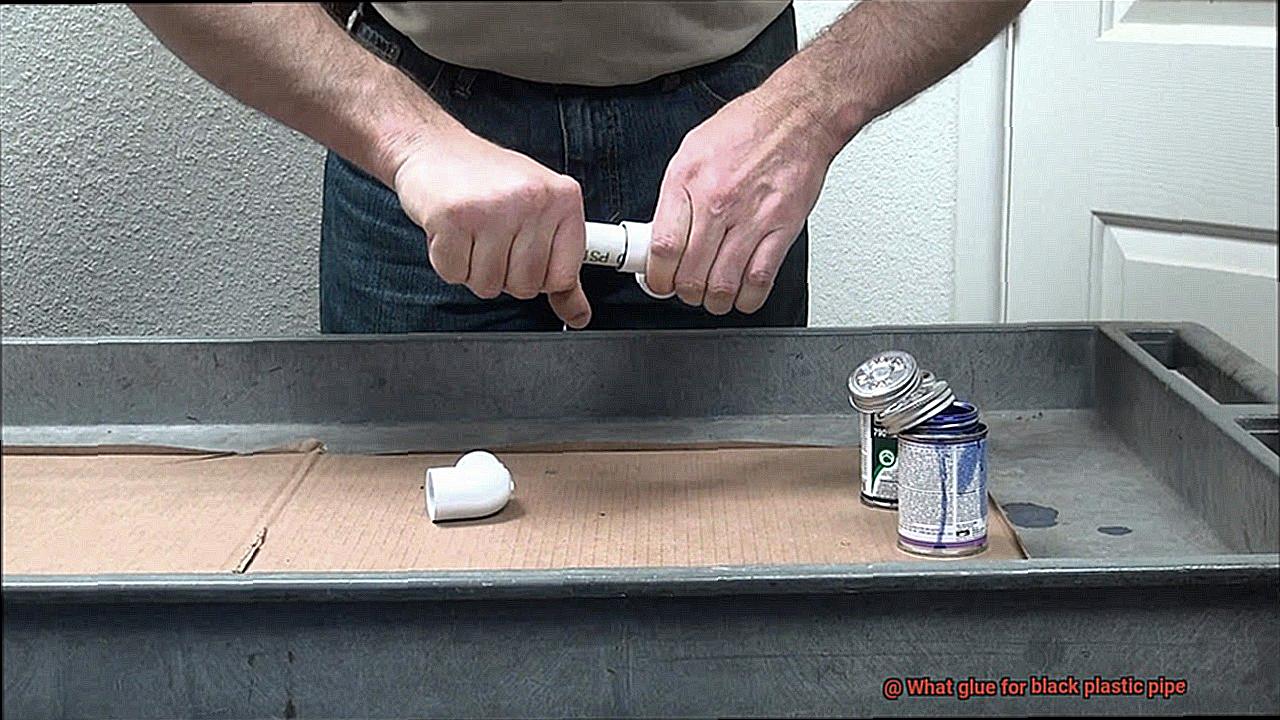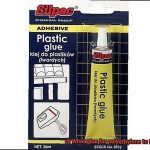Are you knee-deep in a plumbing project that involves black plastic pipes?
Well, you’ve come to the right place. We’re here to help you figure out which glue is the perfect match for your pipes.
After all, finding the right adhesive is crucial to ensure your pipes stay securely connected and leak-free for years to come. With so many options out there, it can be overwhelming to choose the right one.
But don’t worry. In this blog post, we’ll explore the world of black plastic pipe adhesives and guide you towards the best solution for your specific needs.

So, let’s dive in and uncover the secrets behind achieving rock-solid joints with black plastic pipes.
Different Types of Glue for Black Plastic Pipes
Contents
- 1 Different Types of Glue for Black Plastic Pipes
- 2 The Most Common and Recommended Type of Glue for Black Plastic Pipes
- 3 Important Considerations When Choosing a Solvent Cement for Black Plastic Pipes
- 4 Preparing Surfaces Before Applying Solvent Cement
- 5 Applying Solvent Cement to the Pipe and Fitting
- 6 Joining the Pieces Together After Drying
- 7 Allowing Sufficient Time for the Solvent Cement to Cure
- 8 Safety Precautions When Working with Solvent Cement
- 9 Conclusion
Joining black plastic pipes with the right glue is essential for creating strong and leak-free connections. The myriad of glue options available can be overwhelming, leaving you puzzled about which adhesive to choose. Fear not. In this comprehensive guide, we will delve into the different types of glues suitable for black plastic pipes and equip you with the knowledge to make an informed selection.
Solvent Cement: The Powerhouse Glue
Solvent cement reigns supreme as the go-to glue for black plastic pipes, particularly those composed of polyvinyl chloride (PVC). This adhesive exhibits its prowess by chemically bonding the plastic surfaces, resulting in an extraordinarily robust and enduring connection. Renowned for its rapid drying time and exceptional bond strength, solvent cement is tailor-made for plumbing applications. Remember to opt for a solvent cement specifically formulated for PVC pipes and labeled as suitable for pressure applications.
Epoxy Resin: The Versatile Adhesive
Epoxy resin stands as another exceptional option for bonding black plastic pipes. Comprising a resin and a hardener, this two-part adhesive initiates a chemical reaction upon mixing, culminating in an unyielding bond. Epoxy resin flaunts outstanding adhesion properties, proving its mettle in various materials, including plastics. However, exercise caution when selecting an epoxy resin, ensuring compatibility with black plastic pipes, as not all variants are suitable for this application.
Polyurethane Adhesives: Flexibility and Resistance
For black plastic pipes exposed to harsh conditions or chemicals, polyurethane adhesives come to the rescue. These adhesives showcase their resilience by flexing under pressure and resisting the onslaught of water, chemicals, and extreme temperatures. Delivering long-lasting bonds, polyurethane adhesives are ideal when flexibility is paramount.
Rubber-Based Adhesives: Sealing Joints and Connections
When it comes to sealing joints and connections in black plastic pipes, rubber-based adhesives take center stage. These adhesives create a watertight seal, preventing leaks and safeguarding the system’s integrity. Commonly employed in applications where joints or connections experience movement or vibrations, rubber-based adhesives are your trusty allies.
Conclusion:
Selecting the right glue for black plastic pipes is pivotal in forging strong and leak-free connections. Solvent cement, specifically formulated for PVC pipes, stands as the most prevalent and recommended choice. However, epoxy resin, polyurethane adhesives, and rubber-based adhesives offer alternative solutions based on your project’s specific requirements. Remember to consider factors such as the type of black plastic pipe, intended application, and environmental conditions when selecting your adhesive.
The Most Common and Recommended Type of Glue for Black Plastic Pipes
When it comes to joining black plastic pipes, finding the right glue is crucial. You want a bond that can withstand the test of time and keep leaks at bay. So, what’s the go-to adhesive for this task? Look no further than solvent cement, the superhero of black plastic pipe glues. In this blog post, we’ll explore why solvent cement is the most commonly recommended type of glue for black plastic pipes and why it’s the ultimate choice for achieving a strong and durable connection.
Chemical Magic:
Solvent cement works its magic on black plastic pipes by chemically softening their surface. This allows the pipe to fuse seamlessly with another piece of plastic once the solvent evaporates. The result? A leak-proof and durable joint that can withstand high pressure and temperature.
Optimal Compatibility:
When selecting a solvent cement for black plastic pipes, it’s essential to choose one specifically formulated for this material. This ensures optimal adhesion and compatibility, allowing for a reliable bond that will hold up over time. Some popular brands, like Oatey PVC Cement and Weld-On 711 PVC Cement, offer excellent adhesion and durability.
Follow the Instructions:
To achieve the best results with solvent cement, it’s crucial to follow the manufacturer’s instructions. This typically involves cleaning the surfaces to be bonded, applying the cement evenly, and giving it enough time to dry and form a strong bond. By adhering to these instructions, you can ensure a secure and long-lasting connection.
The Alternatives:

While solvent cement is the most commonly recommended glue for black plastic pipes, there are other options available as well. Epoxy resin provides versatility and forms an unbreakable bond through a chemical reaction. Polyurethane adhesives offer resilience against harsh conditions, making them a reliable choice for certain applications. Additionally, rubber-based adhesives excel at sealing joints and connections, creating watertight seals that can be trusted.
Important Considerations When Choosing a Solvent Cement for Black Plastic Pipes
Choosing the right solvent cement for black plastic pipes requires careful consideration of several key factors. These considerations will ensure that you select an adhesive that is compatible with your specific pipe material and environmental conditions, resulting in a strong and reliable joint.
- Determine the type of black plastic pipe: ABS and PVC are common types of black plastic pipes, and each requires a specific type of solvent cement for proper bonding. Check the label or product specifications to ensure compatibility.
- Consider temperature and environmental conditions: Some solvent cements have temperature limitations, and using them outside of their recommended range can affect the strength and durability of the joint. Additionally, factors such as humidity, exposure to chemicals, or UV rays may require the use of a specific type of solvent cement.
- Take into account the size and diameter of the pipes: Different solvent cements may be recommended for different pipe sizes to ensure proper adhesion and a secure connection.
- Prepare the surfaces properly: Follow the manufacturer’s instructions for cleaning and priming the pipe surfaces to achieve maximum adhesion. Inadequate surface preparation can result in weak joints that are prone to failure.
- Ensure safety precautions are taken: Solvent cements often contain volatile organic compounds (VOCs) that can be harmful if inhaled or come into contact with skin or eyes. Wear protective gloves, goggles, and work in a well-ventilated area when using solvent cements.
- Consider drying and curing time: Some solvent cements require longer drying times to achieve full strength, while others may have faster curing times. Understanding these requirements will ensure that the joint is allowed enough time to fully cure before being subjected to pressure or stress.
Preparing Surfaces Before Applying Solvent Cement
When it comes to joining black plastic pipes together, proper surface preparation is crucial for a strong and secure bond. In this article, we will guide you through the step-by-step process of preparing surfaces before applying solvent cement. By following these steps, you can ensure that your black plastic pipe joints will be durable and reliable. So let’s dive in and get started.
Step 1: Clean the Surfaces
Before applying solvent cement, it is essential to clean the surfaces of the black plastic pipes. Use a mild detergent or solvent cleaner specifically designed for plastic pipes to remove any dirt, grease, or debris that may interfere with the adhesive properties of the solvent cement. A clean surface is key to achieving a solid bond.
Step 2: Ensure Dryness
Moisture can compromise the effectiveness of solvent cement, so it is important to ensure that the surfaces are completely dry before application. Use a clean cloth or towel to wipe off any excess moisture and make sure the surfaces are dry to the touch. Moisture-free surfaces are essential for a strong and lasting bond.
Step 3: Sanding for Enhanced Adhesion
To improve adhesion, lightly sand the surfaces of the black plastic pipes. This creates a slightly roughened surface, providing more area for the solvent cement to grip onto. Be careful not to oversand, as this may weaken the integrity of the pipe. A light sanding is sufficient.
Step 4: Wipe Down After Sanding
After sanding, wipe down the surfaces again to remove any dust or residue from the sanding process. A clean cloth or towel can be used for this purpose. This step ensures that your surfaces are clean and ready for the next phase.
Step 5: Cut with Precision
Before applying solvent cement, ensure that the ends of your pipes are cut cleanly and squarely. This ensures a proper fit and a strong bond between the pipes. Use a suitable cutting tool and take your time to achieve precision cuts.
Step 6: Follow Manufacturer’s Instructions
Always follow the manufacturer’s instructions for the specific solvent cement you are using. Different types may have different application methods and drying times. It is crucial to read and understand the instructions thoroughly before proceeding with the application. Adhering to the instructions will help ensure a successful bond.
Applying Solvent Cement to the Pipe and Fitting
Applying solvent cement to join black plastic pipes and fittings is a vital process that guarantees a secure and long-lasting connection. Solvent cement, also known as PVC or CPVC glue, is specifically formulated to bond plastic materials together permanently.
To begin, the pipe and fitting surfaces must be meticulously prepared. Both should be free from any dirt, grease, or moisture that could hinder the bonding process. Start by using a clean cloth or rag to wipe away visible debris. Then, use a mild detergent solution or a PVC cleaner designed for this purpose to thoroughly cleanse the surfaces. Avoid using solvents like acetone or alcohol, as they can damage the plastic material.
Once the surfaces are clean, lightly roughen the outside of the pipe and the inside of the fitting using medium-grit sandpaper or an emery cloth. This step creates a better surface for the solvent cement to grip onto and enhances the overall bond strength.
Now it’s time to apply the solvent cement. Shake the can or container well to ensure proper mixing of the adhesive components. Open it carefully, avoiding spills or contact with your skin.
Using an applicator brush or dauber, generously apply the solvent cement to both the pipe and fitting surfaces. Ensure even coverage, making certain that all exposed areas are coated. Be cautious not to exert excessive pressure, as this may result in excess glue being squeezed out of the joint.
With both surfaces coated in solvent cement, quickly join them together. Align the pipe and fitting properly, ensuring there are no gaps or misalignments. Give them a slight twist or turn to evenly distribute the cement between them.
Hold the joint firmly in place for a few seconds to allow for initial bonding. The solvent cement sets quickly, so it’s crucial to work efficiently during this step. Avoid any movement or disturbance until the cement has fully cured.
Curing time can vary depending on manufacturer instructions and ambient temperature conditions. It is generally recommended to allow at least 24 hours for the solvent cement to fully cure before subjecting the joint to pressure or stress.
Joining the Pieces Together After Drying
Your black plastic pipe pieces are all dried up and ready to be joined together. Now, it’s time to create a connection that will stand the test of time. Get ready to dive into the world of glue and discover the secrets of creating an unbreakable bond.
First things first, cleanliness is key. Give the ends of your pipes a spa treatment before their big moment. Grab a pipe cleaner or a piece of sandpaper and gently scrub away any rough edges or residue that might hinder a perfect bond.
Now, let’s talk about glue. There are two main types to consider: solvent-based glues and cement-based glues. Solvent-based glues, like PVC or ABS pipe glue, chemically melt the plastic, creating an incredible bond between the pieces. They’re the superheroes of the glue world, swooping in with their incredible bonding powers.
On the other hand, cement-based glues, also known as pipe joint compound or pipe dope, fill in the gaps between the pipe pieces, creating a watertight seal. They take a bit longer to dry compared to solvent-based glues, but hey – good things come to those who wait, right?
Once you’ve chosen your glue of choice, it’s time to get down to business. Apply a thin layer of glue to both ends of the pipes, covering every inch. Think of it as spreading love between two destined pieces – coat them with care and precision.
Now comes the moment of truth – joining the pieces together. It’s like solving a puzzle, except there’s only one right way to put the pieces together. Quickly join the pipes and hold them in place for a few seconds to allow the glue to work its magic. Seal the deal with a firm handshake – ensuring an unbreakable bond.
But don’t get too excited just yet. After joining the pieces together, let the glued joint dry and cure for a specific period of time before applying any pressure or using the pipes. Patience is key – let the glue work its wonders and create a bond that can withstand anything life throws at it.
Allowing Sufficient Time for the Solvent Cement to Cure
Joining black plastic pipes using solvent cement is a common practice in plumbing and construction projects. This adhesive creates a strong bond between the pipes, ensuring a watertight seal. However, many people underestimate the importance of allowing sufficient time for the solvent cement to cure before putting any stress on the joint. In this article, we will explore why patience is key when it comes to achieving durable and reliable pipe connections.
Why does curing time matter?
Curing time is the period required for solvent cement to harden and reach its optimal strength. When you join black plastic pipes with solvent cement, the glue chemically melts the plastic, creating a fusion between the two pieces. Rushing this process can weaken the bond and lead to leaks or pipe failure in the future.
Factors affecting curing time:
The curing time of solvent cement varies depending on temperature, humidity, and the specific type of cement used. Generally, it is recommended to wait at least 24 hours before testing the strength of the joint or applying any pressure. Patience is crucial to allow for complete bonding and ensure a sturdy connection.
The importance of avoiding disturbance:
During the curing process, any motion can disrupt the bonding process and compromise the integrity of the joint. It is crucial not to disturb or move the joined pipes. Secure the pipes in place and avoid any unnecessary handling to ensure a strong and secure joint.
Additional strengthening over time:
Even after the initial curing period, the joint continues to strengthen over time. It is advisable to wait a few days before subjecting the joined pipes to full load or pressure. This extra time allows for maximum bond formation and ensures long-lasting durability.
Adapting to varying conditions:
In colder temperatures or high humidity conditions, it may be necessary to extend the curing time to achieve a strong and secure joint. Following the manufacturer’s instructions for the specific solvent cement being used is crucial in such cases. Patience and adherence to proper application techniques will guarantee reliable results regardless of external factors.
Safety Precautions When Working with Solvent Cement
When working with solvent cement, it is crucial to prioritize safety to protect yourself and ensure the effectiveness of your adhesive. Here are some important precautions to follow:
- Wear Protective Gear: Before starting any work with solvent cement, make sure to equip yourself with the necessary protective gear. Safety goggles will shield your eyes from any splashes or spills, while sturdy gloves will protect your hands from chemical contact. Additionally, wearing a respirator or mask is vital to prevent inhaling harmful fumes.
- Work in a Well-Ventilated Area: Solvent cement emits fumes that can be harmful if inhaled excessively. Set up your workspace in a well-ventilated area to minimize exposure to these fumes. Open windows and doors, or use fans and exhaust systems to keep the air flowing smoothly.
- Keep the Work Area Clean and Organized: Maintaining a clean and organized work area is essential for preventing accidents and ensuring proper use of solvent cement. Remove any clutter or debris that could interfere with your work, and keep all tools and materials within easy reach to avoid unnecessary movements that may result in spills or mishaps.
- Store Solvent Cement Properly: When not in use, store solvent cement in a cool, dry place away from direct sunlight and heat sources. Follow the manufacturer’s instructions for storage requirements, and make sure the container is tightly sealed to prevent evaporation or leakage.
- Follow Instructions Carefully: Each brand of solvent cement may have specific instructions for use. Take the time to read and follow these instructions carefully to achieve strong bonds and avoid accidents. Pay attention to recommended drying times, application techniques, and any warnings or precautions provided by the manufacturer.
- Use Solvent Cement Within its Shelf Life: Solvent cement has a limited shelf life indicated on the container. Using expired solvent cement can result in weak bonds or joint failure. Always check the expiration date before using any solvent cement to ensure optimal performance.
- Avoid Contact with Skin and Eyes: Solvent cement is a chemical compound that can cause irritation or burns if it comes into contact with your skin or eyes. In case of contact, immediately wash the affected area with water and seek medical attention if necessary. To minimize the risk of accidental contact, wear gloves and safety goggles.
- Keep Away from Open Flames or Sparks: Solvent cement is highly flammable, so it is crucial to keep it away from open flames, sparks, or heat sources. Smoking should be strictly prohibited in the work area.
- Dispose of Waste Properly: After completing your project, dispose of any leftover solvent cement and used applicators according to local regulations. Do not pour solvent cement down drains or throw it in regular trash bins. Contact your local waste management authorities for guidance on proper disposal methods.
p4gDV6Pe7iI” >
Conclusion
When it comes to gluing black plastic pipes, choosing the right adhesive is crucial.
You want a glue that is specifically designed for this type of material to ensure a strong and durable bond. One popular option is solvent cement, which is specially formulated to work with black plastic pipes.
This adhesive creates a chemical reaction that bonds the pipe and fitting together, creating a tight seal that can withstand pressure and prevent leaks. Another option is polyurethane adhesive, which provides excellent bonding strength and flexibility.
It’s important to carefully follow the manufacturer’s instructions when using any adhesive to ensure proper application and maximum effectiveness.






